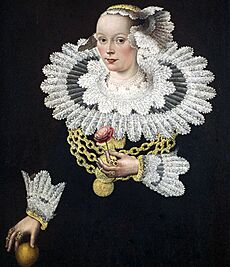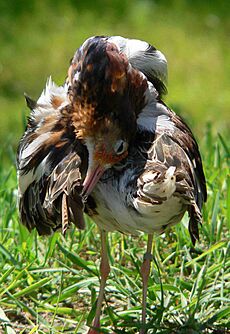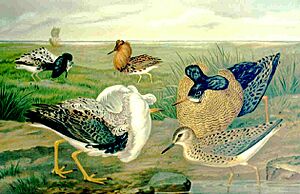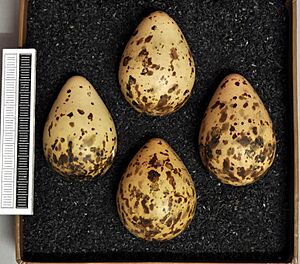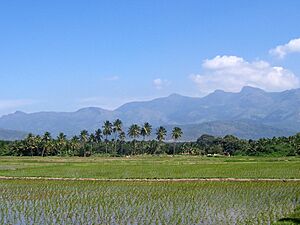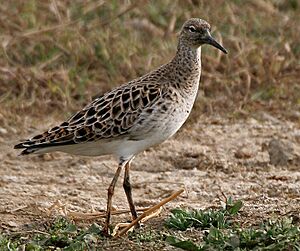Ruff (bird) facts for kids
Quick facts for kids Ruff |
|
|---|---|
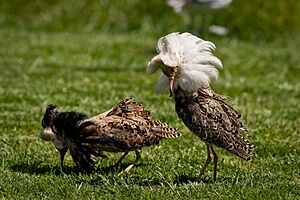 |
|
| Males in breeding plumage in the Netherlands | |
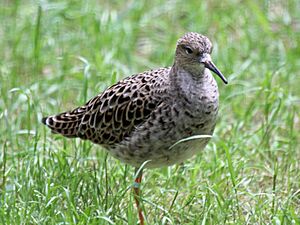 |
|
| Breeding female | |
| Conservation status | |
| Scientific classification | |
| Genus: |
Calidris
|
| Species: |
pugnax
|
 |
|
| Range of P. pugnax Breeding summer visitor Present all year Non-breeding range | |
| Synonyms | |
|
|
The ruff (Calidris pugnax) is a medium-sized wading bird. It breeds in wet areas like marshes and damp meadows across northern Eurasia. This bird loves to be in groups and is a migratory sandpiper. It sometimes forms huge flocks in its winter homes. These homes include southern and western Europe, Africa, southern Asia, and Australia.
The ruff has a long neck and a pot-bellied body. Male ruffs look very different from females. Males are much larger than females, which are called "reeves." During breeding season, males have bright head feathers, orange skin on their faces, and a large collar of fancy feathers. This collar is what gave the bird its English name. Females and non-breeding males have grey-brown backs and mostly white undersides.
There are three types of male ruffs, including a rare one that looks like a female. They use different ways to find mates at a special meeting place called a lek. The colorful head and neck feathers stand up during their fancy courtship dance. The female lays four eggs in a hidden ground nest. She raises the chicks by herself. The chicks can move around soon after hatching. Predators of ruff chicks and eggs include foxes, feral cats, stoats, large gulls, crows, and skuas.
Ruffs look for food in wet grasslands and soft mud. They probe or look for food. They mostly eat insects, especially when breeding. But they also eat plants, like rice and corn, when migrating or in winter. The ruff is listed as "least concern" by the IUCN Red List. This means there are still many ruffs in the world. However, their numbers are shrinking in parts of Europe. This is due to land being drained, more fertilizer being used, and hunting. Because of this decline, the ruff is now listed in the Agreement on the Conservation of African-Eurasian Migratory Waterbirds (AEWA).
Contents
Understanding the Ruff's Name and Family
The ruff is a wader bird. It belongs to the large family called Scolopacidae, which are typical shorebirds. Scientists think its closest relatives are the broad-billed sandpiper and the sharp-tailed sandpiper. There are no different types or subspecies of the ruff based on where they live.
The famous scientist Carl Linnaeus first described this bird in 1758. He called it Tringa pugnax. Later, a German naturalist named Blasius Merrem moved it to its own group, Philomachus. But newer DNA research shows it fits well into the wader group Calidris. The name Calidris comes from an Ancient Greek word for grey waterside birds. The word pugnax comes from Latin and means "combative" or "ready to fight." This refers to how aggressive the male ruffs are at their mating areas.
The name "ruff" for the bird was first used in 1634. It comes from the fancy, ruffled collar called a ruff that was popular in the 16th and 17th centuries. The male bird's neck feathers look like this collar. The female is still sometimes called a "reeve."
What Does a Ruff Look Like?
The ruff has a unique shape, like a "gravy boat." It has a small head, a medium-sized bill, a longish neck, and a pot-bellied body. Its long legs can be different colors. Young birds have dark green legs. Adults have pink to orange legs. Some males have reddish-orange legs only during breeding season. When flying, the ruff flaps its wings slower than other similar-sized waders. It shows a thin white bar on its wing and white ovals on the sides of its tail.
Male and female ruffs look very different. The male is much larger than the female. He also has special feathers for breeding. Males are about 29–32 centimeters (11–13 inches) long. Their wingspan is about 54–60 centimeters (21–24 inches). They weigh about 180 grams (6.3 ounces).
During the breeding season (May to June), the male's legs, bill, and bare face skin turn orange. He grows special head tufts and a neck ruff. These feathers can be black, chestnut, or white. They can be solid, striped, or have irregular patterns. The male's back is grey-brown with a scale-like pattern. His belly is white, with a lot of black on his chest. The many different looks of the male's feathers help them recognize each other. This is important because they display together but are usually quiet.
After the breeding season, the male loses his fancy head and neck feathers. His bare face skin disappears, and his legs and bill become duller. His back turns grey-brown, and his belly is white with grey spots on the chest and sides.
The female, or "reeve," is smaller. She is about 22–26 centimeters (8.7–10.2 inches) long. Her wingspan is about 46–49 centimeters (18–19 inches). She weighs about 110 grams (3.9 ounces). When breeding, her back is grey-brown with dark-centered feathers that have white edges. Her chest and sides have black spots. In winter, females look similar to males, but you can tell them apart by their size. Young ruffs look like non-breeding adults. They have a neat, scale-like pattern on their backs and a strong buff color on their undersides.
Young male ruffs develop their breeding feathers later than older males. This might be because they need a lot of energy for their long migration flights.
Where Ruffs Live and Travel
The ruff is a bird that migrates. It breeds in wetlands in the colder parts of northern Eurasia. It spends the northern winter in warmer, tropical areas, mostly in Africa. Some ruffs from Siberia fly up to 30,000 kilometers (18,600 miles) each year to their winter homes in West Africa.
Ruffs breed in large, flat freshwater marshes and damp grasslands. They like areas with shallow water and small mounds. The wet areas provide food, and the mounds are used for their special mating displays (leks). Dry areas with sedge or low bushes are good for nesting. Ruffs can be found in Europe and Asia, from Scandinavia and Great Britain all the way to the Pacific Ocean. The largest numbers breed in Russia, Sweden, Finland, and Norway.
When migrating, ruffs fly in huge flocks. These flocks can have hundreds or even thousands of birds. In their winter homes, they form very dense groups. One flock in Senegal had a million birds! Some ruffs winter further east in places like Burma, southern China, New Guinea, and parts of Australia. They can also be found on the Atlantic and Mediterranean coasts of Europe.
Male ruffs leave the breeding grounds in late June or early July. Females and young birds follow later in July. Males usually fly shorter distances and winter further north than females. For example, most ruffs wintering in Britain are males, while most in Kenya are females. This helps reduce competition for food between males and females. It also lets males get back to the breeding grounds early to find mates.
Ruff Behavior and Life Cycle
Mating and Male Types
During the breeding season, male ruffs gather at a special open grassy area called a lek. Here, they perform displays mostly for other males, not just females. The ruff is one of the few birds where males have different looks and mating behaviors that they inherit.
There are three types of male ruffs:
- Territorial males: About 84% of males are this type. They have dark-colored ruffs (black or chestnut). They claim and defend small mating areas at the lek. They try to attract females and are aggressive towards other territorial males. They perform fancy displays like wing fluttering, jumping, and lunging at rivals. They are usually quiet during these displays. These males often return to the same lekking spots each year.
- Satellite males: About 16% of males are this type. They have white or mottled ruffs. They do not claim territories. Instead, they enter the leks and try to mate with females visiting the territories of other males. Territorial males usually allow satellite males to be there. This is because having both types of males on a territory attracts more females.
- Faeder males: This type is very rare, about 1% of males. They look like females and do not grow the fancy breeding feathers. These "faeder" males can get close to mating territories along with the females. They sometimes "steal" matings. Faeder males migrate and spend winter with the larger lekking males.
Not all mating happens at the lek. Some males find mates by chasing females directly or waiting for them near good feeding spots.
Ruffs have a very high rate of polyandry. This means that more than half of female ruffs mate with, and have eggs fertilized by, more than one male. Females can choose mates without worrying about losing help with nesting or raising chicks, because male ruffs don't help with that anyway.
Genetics of Male Variation
The three types of male ruffs—territorial, satellite, and faeder—have different behaviors and looks. These differences are controlled by their genes. For example, the territorial behavior and look are recessive to the satellite behavior and look. This means that the satellite traits are more likely to show up if the gene is present. Scientists have found that the genes for these mating strategies are on a non-sex chromosome. This means both male and female ruffs can carry these different gene forms. Females don't usually show these male behaviors, but if they are given testosterone, they will act like the male type their genes tell them to be.
Scientists have found that a change in a specific part of a chromosome causes these differences. This change happened millions of years ago. It created the faeder type first, and then the satellite type. These genetic changes affect how certain hormones, like testosterone, are produced in the males. This helps explain why the different male types look and act the way they do.
Nesting and Survival

The ruff builds a shallow nest on the ground. It lines the nest with grass leaves and stems. The nest is hidden in marsh plants or tall grass, usually within 400 meters (440 yards) of the lek. Females nest alone. They lay eggs from mid-March to early June, depending on how far north they are.
A typical clutch has four eggs. Each egg is about 44 x 31 millimeters (1.7 x 1.2 inches) and weighs about 21 grams (0.74 ounces). The female incubates the eggs by herself. The eggs hatch in 20–23 days. The chicks can fly after another 25–28 days. The chicks are born able to move and feed themselves. They eat small invertebrates. The female broods, or keeps them warm. Ruffs raise one group of chicks each year.
Sometimes, there are more females than males among young ruffs. Females in poor physical condition might produce more male eggs. When females are healthier, the number of males and females is more balanced.
Predators of ruff chicks and eggs include large gulls, common ravens, carrion and hooded crows, and great and Arctic skuas. Foxes sometimes eat waders. The effect of feral cats and stoats is not fully known. Too much grazing by animals can make nests easier for predators to find. Ruffs can start breeding in their second year. The average lifespan for a ruff that survives past the chick stage is about 4.4 years. One ruff in Finland lived for almost 14 years!
Feeding Habits
The ruff usually feeds by walking steadily and pecking at food. It chooses food items by sight. But it can also wade deeply and put its head underwater. In some salty lakes in East Africa, it even swims like a phalarope, picking food off the surface. Ruffs feed both day and night. They are thought to use both sight and sound to find their prey. When feeding, the ruff often raises its back feathers, making a loose peak on its back.
During the breeding season, ruffs eat mostly adult and young insects. These include beetles and flies. When migrating and in winter, ruffs eat insects, crustaceans, spiders, mollusks, worms, frogs, and small fish. They also eat seeds from rice, other grains, grasses, and water plants. Ruffs migrating through Italy change their diet based on what food is available at each stop. In West Africa, rice is a favorite food in late winter when the rice fields dry out.
Before migrating, ruffs gain weight by storing fat. They gain about 1% of their body mass each day. This is slower than some other birds, like bar-tailed godwits. This is because ruffs can stop regularly to feed during their overland migration. Godwits, however, fly over the Pacific Ocean and cannot stop to refuel.
Ruffs and People
Ruffs used to be caught for food in England in large numbers. In 1465, 2,400 ruffs were served at a big banquet! The birds were caught with nets at their lekking sites. Sometimes, they were fattened up with bread, milk, and seeds before being prepared for eating.
This heavy hunting, along with habitat loss from draining wetlands, caused the ruff to almost disappear in England by the 1880s. However, small numbers have returned since 1963. Draining wetlands in southern Sweden also caused ruffs to disappear from many areas there. The use of insecticides and draining wetlands has led to fewer ruffs in Denmark since the early 1900s. In some places, ruffs and other wetland birds are still hunted. For example, over a million waterbirds, including ruffs, were caught in one year from Lake Chilwa in Malawi.
Even though ruffs eat rice in their winter homes, they mostly eat leftover rice and waste from harvesting. They don't usually eat the main crop. So, they are not usually a pest to farmers.
Protecting the Ruff Bird
The ruff lives across a very large area, estimated to be 1–10 million square kilometers (0.38–3.8 million square miles). There are at least 2,000,000 ruffs in the world. The European population, which is about 200,000–510,000 pairs, seems to have decreased by up to 30% in ten years. But this might be due to changes in where they breed. Globally, the ruff is listed as a least concern species. However, in 2021, the European population was listed as near-threatened. This means it could be listed as more at risk in the future.
The largest ruff populations in Europe, found in Russia and Sweden, are stable. The breeding range in Norway has even grown south. But populations have more than halved in Finland, Estonia, Poland, Latvia, and The Netherlands. Even though these smaller populations are not a huge part of the total, their decline shows a trend of the ruff's range shrinking over the last two centuries. The drop in numbers in Europe is blamed on draining wetlands, more fertilizer use, losing old breeding sites, and too much hunting.
Fossils show that ruffs used to breed further south in Europe during colder times. Their sensitivity to climate change, water levels, and plant growth suggests they could be an indicator species for monitoring global warming. Potential threats also include diseases like bird flu, botulism, and avian malaria.
The ruff is part of the Agreement on the Conservation of African-Eurasian Migratory Waterbirds (AEWA). This agreement means that countries must protect ruffs and their habitats. They also need to control hunting and monitor the bird's populations.




